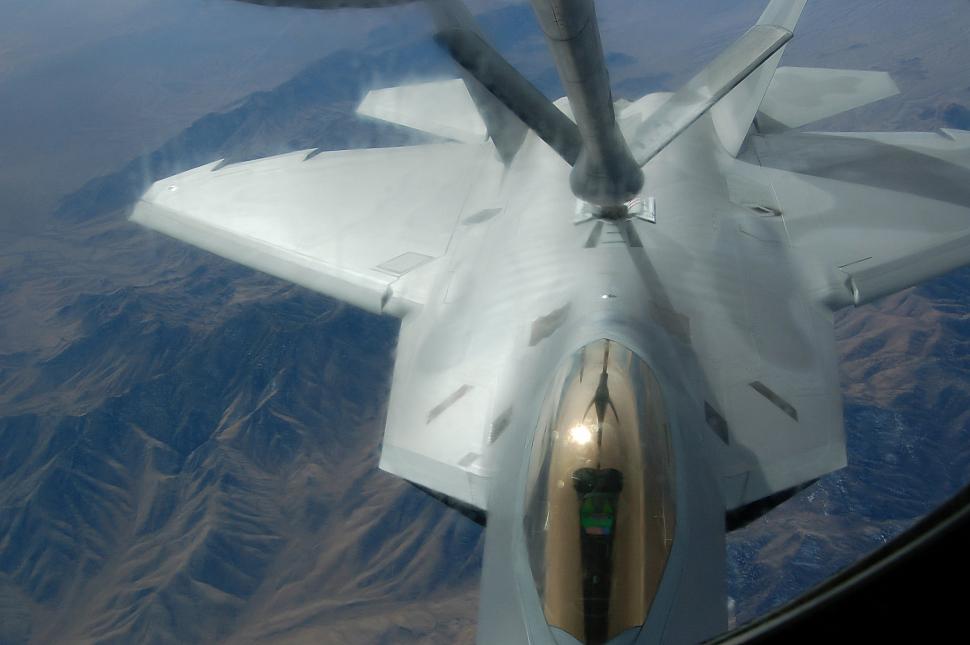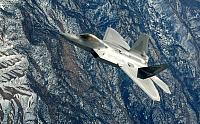Fighter Jet News
F-22 Raptor News
The F-22 learns how to play well with others
February 21, 2007 (by
Harold C. Hutchison) -
Recent "Red Flag" air combat exercises at Nellis Air Force Base have been dominated by the F-22 again. After a two-decade development program and tons of criticism about its price tag, the F-22 is proving to be worth every penny.

However, the real process that will make the F-22 dominate in the air was not so much the lengthy gestation and development of the F-22 by the United States Air Force, but what is going on now.
Through exercises like Red Flag, American pilots are learning how to apply the F-22's strengths in combat situations. This is an old process, and has happened before. For example, back in early 1942, the Japanese Zero was considered the best naval fighter plane in the world. Often, U.S. F4F Wildcats were shot down when they tried to dogfight. However, Navy and Marine pilots eventually began to learn how to use the strengths of the F4F through tactics like the Thach Weave, and eventually, the Wildcat was able to hold its own against the Zero. It worked, but it was expensive in terms of planes – and more importantly, pilots – lost in battle.
The breakthrough in learning a plane's weaknesses and strengths in combat without the heavy losses began after studies during the Vietnam War indicated that a pilot's chances of survival increased after the first ten missions he flew. Today, the mistakes made in those missions don't get made on the battlefield, they are made during a training exercise like "Red Flag" or the navys "Top Gun". The razzing from fellow pilots and the resulting embarrassment might be tough to deal with, but it beats being shot down.
The exercises are also showing just how good of a plane the F-22 is. In hundreds of simulated engagements against multiple aircraft like the F-15 and F-16, the F-22 has dominated. Still, keeping in mind how the "inferior" F4F was able to hold its own against the Zero, the Air Force has been emphasizing the ability of the F-22s to work together with not just F-22s, but other planes. The latest exercises featured the F-22 working with Tornados, Typhoons, F-15s, F-16s, F-111s, and F-117s.
The Air Force has been serious about making the F-22 the best fighter in the world, and addressing the issues that come with it. With the R&D costs recouped, new F-22s will be more affordable to build as long as the production line is running. That is the only question about the F-22's future.

An F-22 Raptor from the 1st FW at Langley AFB, tops off from a KC-135 Stratotanker during the Red Flag Exercise at Nellis AFB, Nev on Feb 7th 2007. Two KC-135s from the 319th ARW at Grand Forks AFB, make up the lead tanker unit during the exercise. [USAF photo by 1st Lt. Randi Norton]
Through exercises like Red Flag, American pilots are learning how to apply the F-22's strengths in combat situations. This is an old process, and has happened before. For example, back in early 1942, the Japanese Zero was considered the best naval fighter plane in the world. Often, U.S. F4F Wildcats were shot down when they tried to dogfight. However, Navy and Marine pilots eventually began to learn how to use the strengths of the F4F through tactics like the Thach Weave, and eventually, the Wildcat was able to hold its own against the Zero. It worked, but it was expensive in terms of planes – and more importantly, pilots – lost in battle.
The breakthrough in learning a plane's weaknesses and strengths in combat without the heavy losses began after studies during the Vietnam War indicated that a pilot's chances of survival increased after the first ten missions he flew. Today, the mistakes made in those missions don't get made on the battlefield, they are made during a training exercise like "Red Flag" or the navys "Top Gun". The razzing from fellow pilots and the resulting embarrassment might be tough to deal with, but it beats being shot down.
The exercises are also showing just how good of a plane the F-22 is. In hundreds of simulated engagements against multiple aircraft like the F-15 and F-16, the F-22 has dominated. Still, keeping in mind how the "inferior" F4F was able to hold its own against the Zero, the Air Force has been emphasizing the ability of the F-22s to work together with not just F-22s, but other planes. The latest exercises featured the F-22 working with Tornados, Typhoons, F-15s, F-16s, F-111s, and F-117s.
The Air Force has been serious about making the F-22 the best fighter in the world, and addressing the issues that come with it. With the R&D costs recouped, new F-22s will be more affordable to build as long as the production line is running. That is the only question about the F-22's future.
Courtesy of strategypage.com
Related articles:
Forum discussion:
Tags
- F-22s make mark at Red Flag ( 2007-02-15)
- Red Flag ramps up, F-22 to make debut ( 2007-01-14)
- F-22 Raptor news archive
Forum discussion:
- The F-22 learns how to play well with others ( 10 replies)
Tags
Additional images:

F-22 Raptors fly off the left wing of a KC-135 Stratotanker during the Red Flag Exercise on Feb 7th 2007. Two KC-135 Stratotankers from the 319th ARW at Grand Forks Air Force Base make up the lead tanker unit during the exercise. [USAF photo by 1st Lt. Randi Norton]


